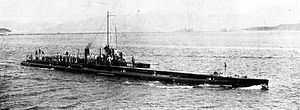French submarine Monge (Q67)
 French submarine Monge | |
| Career (France) | |
|---|---|
| Name: | Monge |
| Namesake: | Gaspard Monge |
| Ordered: | 24 August 1905 |
| Builder: | Arsenal de Toulon |
| Laid down: | 8 October 1905 |
| Launched: | 31 December 1908 |
| Commissioned: | 2 August 1910 |
| Fate: | Sunk in action, 29 December 1915 |
| General characteristics [1] | |
| Class and type: | Pluviôse-class submarine |
| Displacement: | 398 t (392 long tons), surfaced 550 t (540 long tons) submerged |
| Length: | 167 ft 4 in (51.00 m) |
| Beam: | 16 ft 4 in (4.98 m) |
| Draft: | 10 ft 3 in (3.12 m), surfaced |
| Propulsion: | 2 × propeller shafts 2 × Du Temple boilers 2 × reciprocating steam engines, surfaced, 700 ihp (520 kW) total 2 × electric motors, submerged, 450 shp (340 kW) total |
| Speed: | 12 knots (14 mph; 22 km/h), surfaced 8.8 knots (10.1 mph; 16.3 km/h), submerged |
| Range: | 1,500 nmi (2,800 km) @ 10 knots (19 km/h), surfaced 50 nmi (93 km) @ 5 knots (9.3 km/h), submerged |
| Complement: | 24 |
| Armament: | 1 × 17.7 in (450 mm) bow torpedo tube, up to 8 torpedoes |
French submarine Monge (Q67) was a Laubeuf type submarine[2] of the Pluviôse class, built for the French Navy prior to World War I.[1]
Design and construction
Monge was ordered by the French Navy as part of its 1905 programme and was laid down at the Toulon Naval Yard in October of that year. She was launched on 31 December 1908 and commissioned 2 August 1910. Monge was equipped with Du Temple boilers and reciprocating steam engines for surface propulsion, and CGE Nancy electric motors for power while submerged. She carried eight torpedoes, two internally and six externally.[1] Monge was named for Gaspard Monge, the 18th century French mathematician and Minister of Marine.[3]
Service history
At the outbreak of the First World War Monge was part of the French Mediterranean Fleet and sailed with that force to the Adriatic tasked with bringing the Austro-Hungarian Fleet to battle or blockading it in its home ports.
On 29 December 1915, while on patrol off Cattaro, under the command of Lt. Roland Morillot, Monge sighted the cruiser Helgoland and a destroyer escort. She closed to attack, but was spotted and rammed by Helgoland. She surfaced and was abandoned, her commander staying aboard to ensure she sank. For this action Morillot was honoured by having a submarine, the captured German UB-26, renamed after him.[3][4]
Notes
References
- Gardiner R, Gray R: Conway’s All the World’s Fighting Ships 1906-1921 (1985) ISBN 085177 245 5
- Moore, J: Jane’s Fighting Ships of World War I (1919, reprinted 2003) ISBN 1 85170 378 0
External links
- Castel, Marc: Monge at Sous-marins Français 1863 -, pagesperso-orange.fr (French)
- Sieche, Erwin: French naval operations in the Adriatic at gwpda.org
| ||||||||||